Dissolvable stitches are a type of thread widely used in medicine to suture wounds. After a short time, the stitches will disappear on their own without the need to remove the stitches. Widely used dissolvable stitches include: Simple Catgut, Polydioxanone, Poliglecaprone and Polyglactin.
Normally, the dissolvable stitches usually lasts about 20 – 90 days, depending on the type of thread.
What are dissolvable stitches? Distinguish between self-absorbing and non-absorbable sutures
What are dissolvable stitches? Dissolvable stitches are a type of suture made from special materials that biological enzymes in the body will break down and absorb.
The names dissolvable stitches and regular sutures clearly indicate the difference between the two types. You can simply understand that dissolvable sutures will disappear within a short time after the wound has completely healed. Meanwhile, sutures cannot disappear on their own, so it is necessary to replace them.
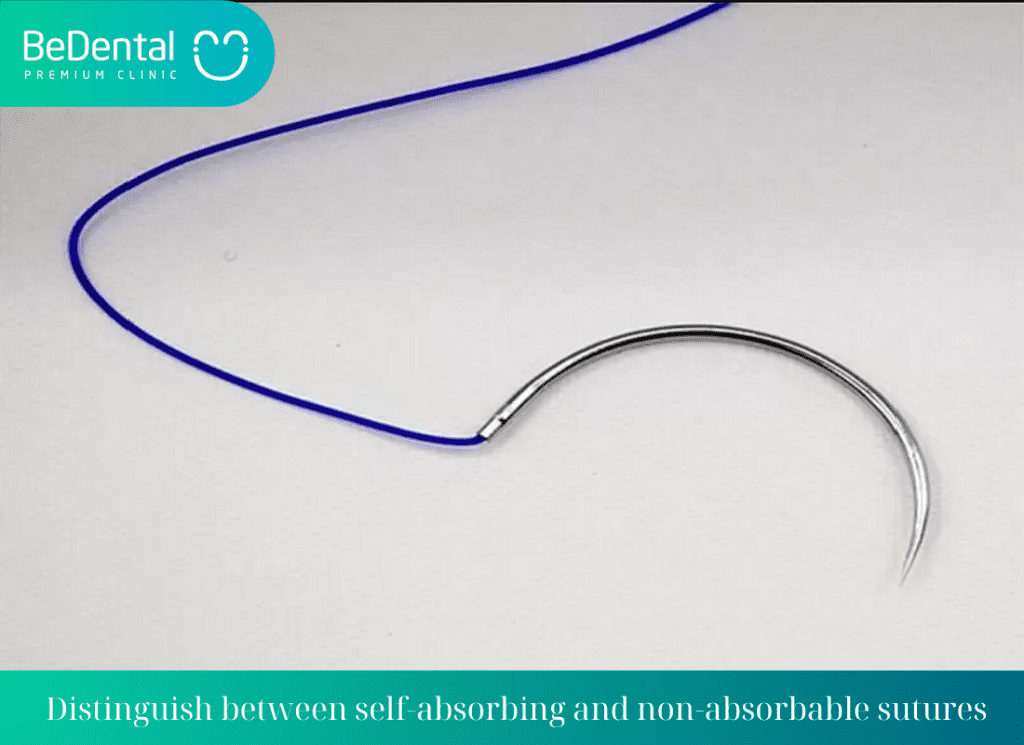
Dissolvable stitches are commonly used in suturing wounds (surgical procedures) to help speed up healing and blood clotting.
After a period of time when the wound is completely healed, the body’s enzymes will help the sutures completely dissolve without causing pain or bleeding. Thanks to its convenience and body safety, this type of thread has gradually replaced hand-drawn thread.
See more: Choosing between dental fillings for tooth erosion or dental crowns
Dissolvable stitches are commonly used
Currently, 4 types of dissolvable stitches are widely used: Simple Catgut, Polydioxanone, Poliglecaprone and Polyglactin. Join us to learn more about the characteristics of each type above in the section below.
Simple Catgut dissolvable stitches
Simple Catgut thread is made from sheep intestinal mucus combined with serum from cow intestines. The above suture contains up to 98% absorbable collagen. In addition, the thread has a twisted or single thread structure so it is very durable.
Simple Catgut absorbable sutures are often used for wounds and lacerations deep within soft tissue, especially gynecological surgeries. For neurological or cardiovascular surgery, doctors will not use the above thread.
Polydioxanone absorbable thread (PDS)
PDS thread is a single-strand thread but is made of a flexible polymer that allows doctors to easily suture soft tissue wounds, especially heart surgeries with long healing times.
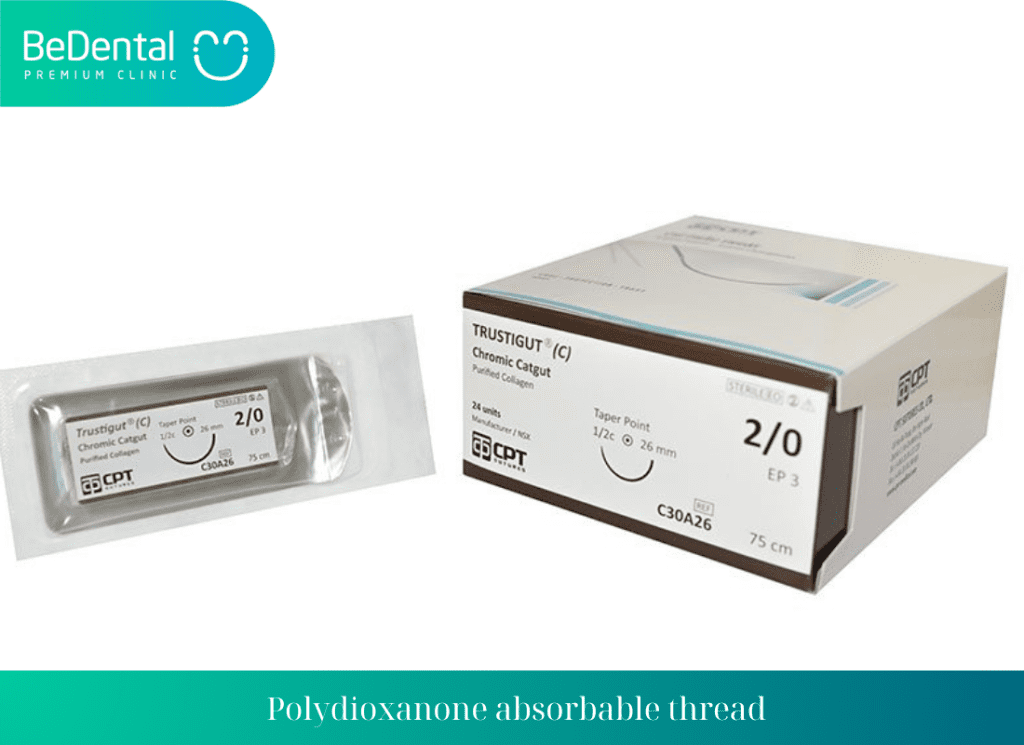
They are also used in many types of open tissue wounds (such as abdominal closure). In addition, compared to Simple Catgut suture, PDS suture can completely be used for heart surgeries in children.
Polyglecaprone thread (MONOCRYL)
PDS thread is a single-strand thread but is made of a flexible polymer that allows doctors to easily suture soft tissue wounds, especially heart surgeries with long healing times.
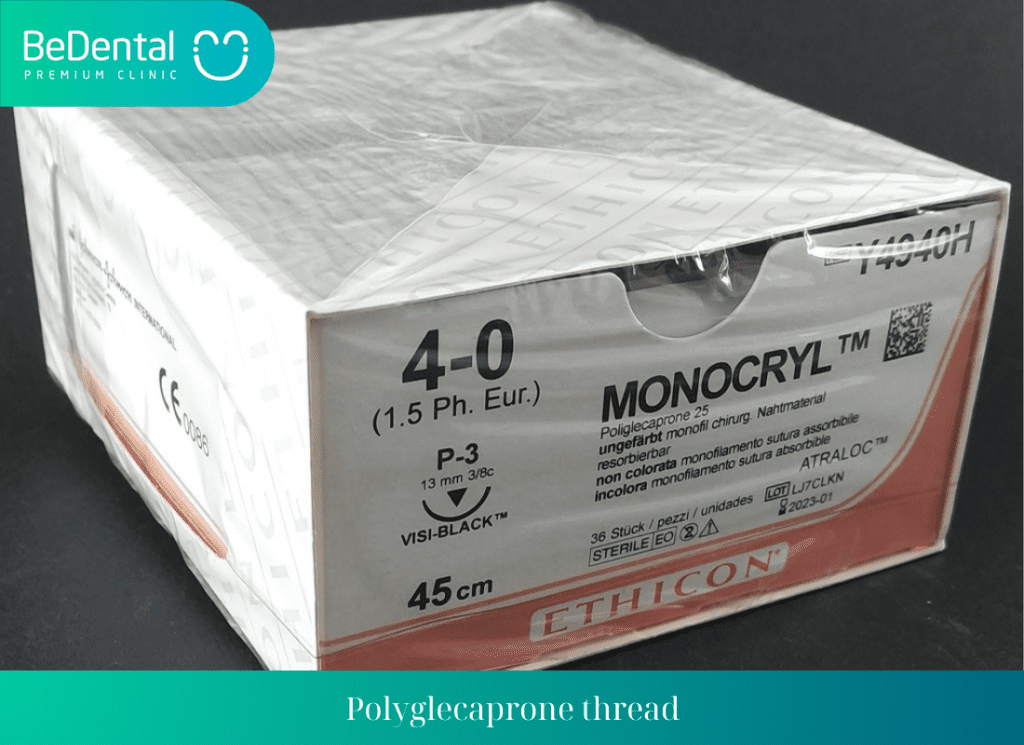
They are also used in many types of open tissue wounds (such as abdominal closure). In addition, compared to Simple Catgut suture, PDS suture can completely be used for heart surgeries in children.
Polyglactin thread (Vicryl)
This type is only synthesized from 3 substances: glycolic, lactic acid and copolymer acid. The outer part is surrounded by a layer of polyglactin 370 and calcium stearate. Polyglactin will be softened when it reaches each cell, thereby reducing irritation and speeding up wound recovery.
See more: 5 ways to fix a frontal bossing
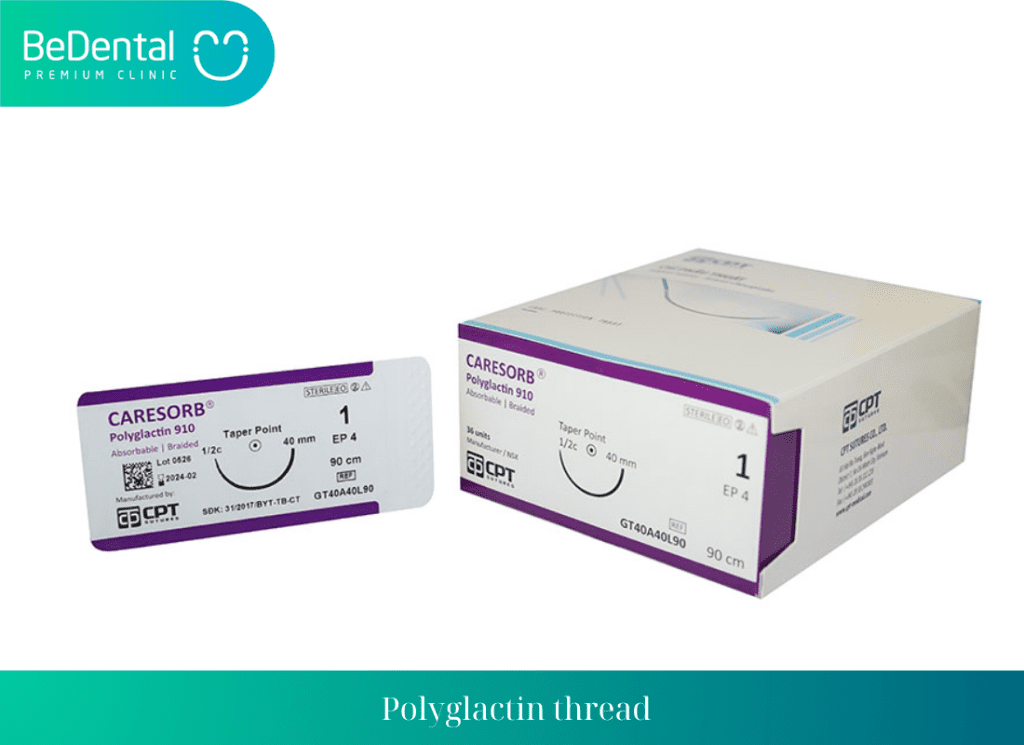
Polyglactin thread is a great choice for wounds on the palms or face. However, they are not suitable for use in cardiovascular or neurological surgery.
In what cases are dissolvable stitches used?
In what cases are dissolvable stitches used? Dissolvable stitches help reduce the number of follow-up visits, thereby limiting scarring and infection. However, depending on the depth, shape and size of the wound, the doctor will use different types of sutures.
For skin wounds, sutures are more commonly used because of their sturdiness when colliding with objects.
Biodegradable threads are suitable for suturing wounds deep in soft tissue. In addition, for wounds in areas with good elasticity, thread is also used by doctors to make stitching easier and minimize the risk of scarring.
See more: Swelling after wisdom tooth extraction
Below are a few situations where doctors will use biodegradable surgical threads:
- Wounds on the mouth and skin heal quickly and help avoid scarring.
- Closing ulcers of the tongue or oral mucosa (such as wisdom tooth extraction).
- Skin transplant surgery.
- Surgery for ruptured vagina and connective tissues.
- Vaginal and perineal incisions are made.
- Circumcision.
- Surgery at home.
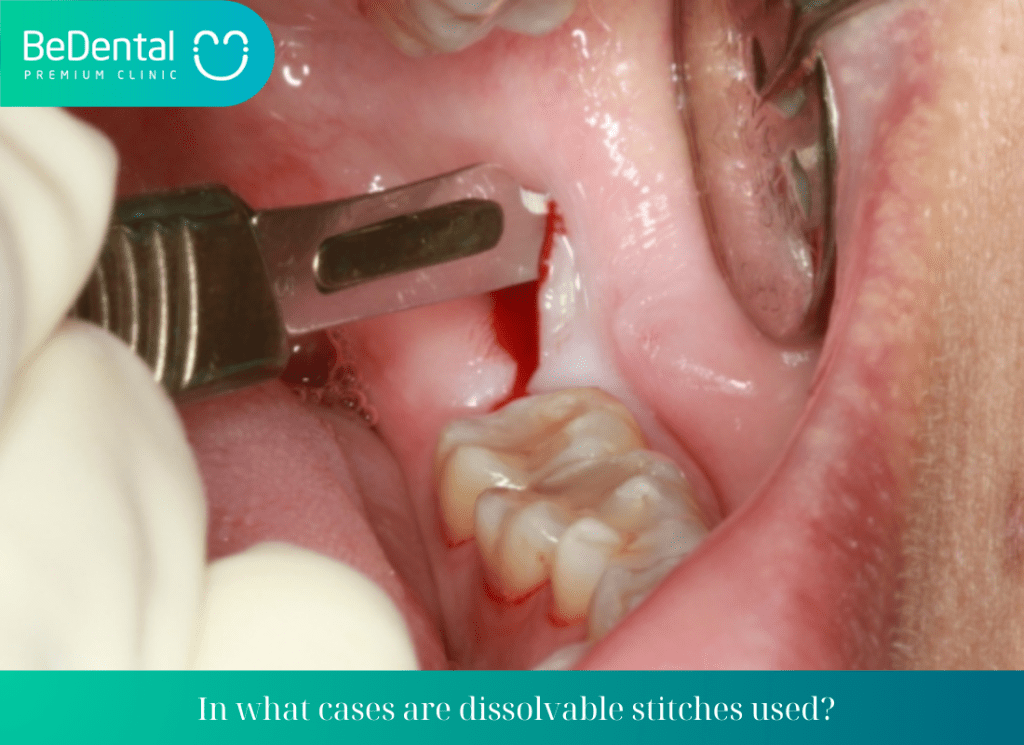
What color are the dissolvable stitches?
What color is the dissolvable stitches? Dissolvable surgical sutures are usually purple, blue, black or striped to easily contact the surrounding soft tissues, making the suturing process convenient and limiting cases of mishandling the sutures.
Most dissolvable stitches are usually dyed a dark color to match the thread color; there are few cases of changing the natural suture color. The most common thing we see is Polyglactin sutures that are purple.
However, there are also cases where doctors will use clear or white dissolvable stitches (Poliglecaprone and Polyglactin) to help achieve the best results, especially with wounds on the face.
See more: Which country is 3M Lava Porcelain Teeth from? How Many Types Are There? Detailed Review
How long will it take for dissolvable stitches to self-destruct?
Normally, sutures will dissolve on their own in about 20 – 90 days. Only going through different breakdown processes such as: hydrolysis (with polyglycolic acid), enzymatic degradation, proteolysis… They will hold the body tissues together long enough to heal the wound, then will spontaneously dissolve without leaving foreign objects on tissue.
Depending on the type of thread, the dissolution time of the suture will be different, specifically as follows:
- Polyglactin only: 90 days.
- Polydioxanone only: 90 days.
- Poliglecaprone only: 20 days.
- Simple Catgut only: 70 days.
Self-degradable thread has a half-life of 7 – 14 days, retains about 20 – 30%, decomposes strongly in the next two weeks and is completely absorbed after 100 days. When you first use absorbable sutures, you may experience some signs of reaction, but these are only temporary. After the reabsorption process, only normal connective tissue remains.
What should I do if the thread is not completely consumed? Can it be cut?
If after 100 days the dissolvable stitches still do not decompose completely, you should go to a reputable medical facility to ask a doctor to remove the sutures. In principle, dissolvable stitches do not need to be cut. However, in some cases they are not tolerated by the body and can cause infection.
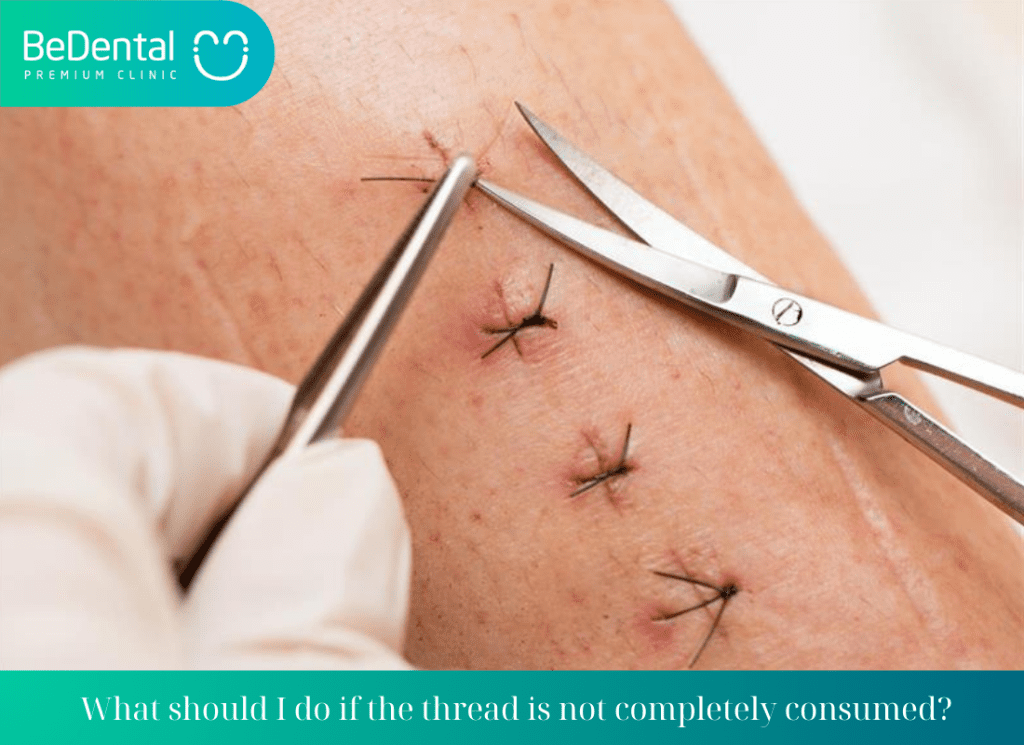
When you encounter the above situation, you don’t need to worry too much because self-decomposing threads can be cut out like regular sutures. During wound treatment, the doctor will widen the stitches a little more. After the wound is less swollen, the soft tissues will shrink and expose the sutures, allowing the doctor to quickly remove the sutures.
Are dissolvable stitches easy to break?
Are dissolvable stitches easy to break? Dissolvable sutures are made mainly from natural materials with high durability and flexibility, so if left under normal conditions, they will not break. However, compared to regular sutures, dissolvable sutures are not as strong.
When exposed to strong external forces, the thread can completely break. This is also the reason why doctors often use it for skin wounds.
At the time of half-life or decomposition, the thread is most likely to break. Therefore, you should follow your doctor’s instructions in wound care at home to minimize the risk of stitch breakage and speed up wound recovery.
Should I remove the dissolvable stitches myself or not?
According to recommendations from leading doctors, you should not try to remove stitches yourself at home. Because just one small mistake can cause you to face many risks such as: thread breakage, prolonged pain, bleeding…
Besides, the above thread will also self-decompose and be absorbed by the body when the wound has healed, so removing the thread yourself is unnecessary. In case the stitches do not disappear after about 100 days, you should go to a medical facility to have the doctor remove the stitches to limit infection as well as other serious complications that may occur.
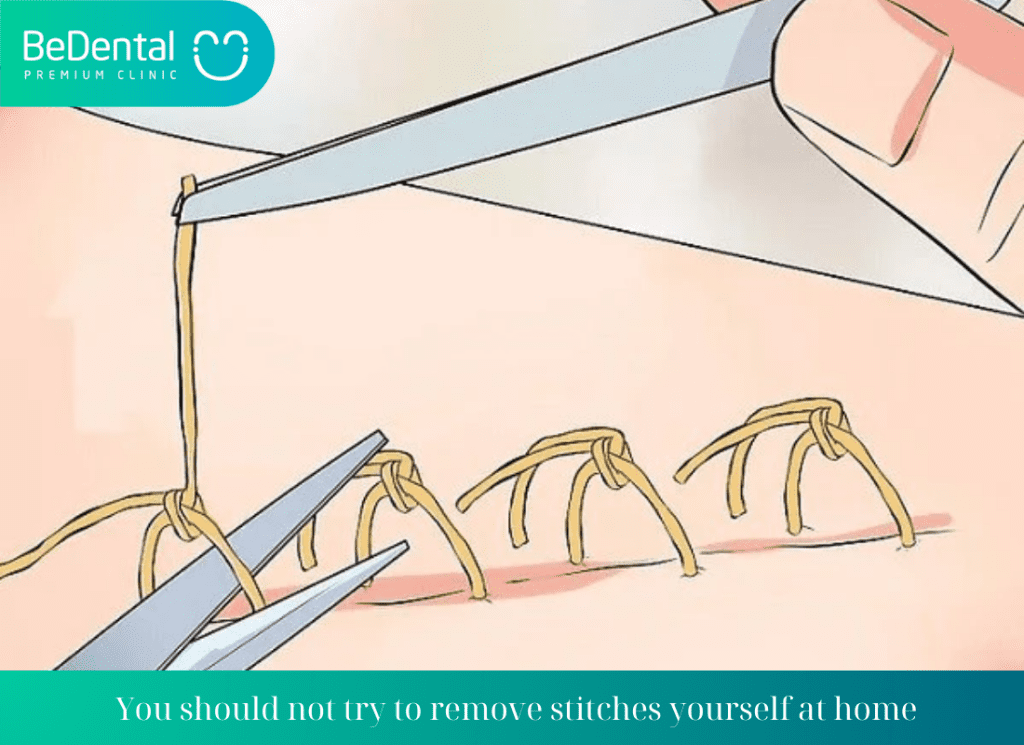
Are there any complications when using dissolvable stitches?
Only self-destructive surgery is simple and does not affect the body. However, in reality there are also many cases of infectious complications after wound surgery.
The main causes of the above situation are lack of reputation in medical facilities, equipment that does not meet quality standards and improper wound care. Infection is often accompanied by characteristic signs such as: red, swollen skin around the wound, prolonged pain, copious secretions, fever and swelling…
See more: How many types of anti-teeth grinding troughs are there?
How to care for stitches with dissolvable stitches
The dissolvable stitches will quickly disappear without any intervention. However, in order for the wound to recover quickly and limit possible complications of infection and prolonged pain, you need to pay attention to the following:
- Wear clothes that are tight and loose enough to cover the stitches and avoid exposing the wound to sunlight and dust… Do not apply strong impact to the wound because it can easily lead to infectious complications.
- Care according to your doctor’s instructions helps speed up the wound recovery process.
- Keep the wound area clean.
- During the first 12 – 24 hours, you should not swim or bathe.
- If you detect signs of infection such as redness, swelling, pus, fever, and lots of blood flowing through the skin. .. you need to immediately go to a reputable medical facility to promptly treat and stitch the wound.
The above article is some of the most basic knowledge related to dissolvable stitches that we want to send to you. In short, absorbable thread is a type of produced with materials that are easily broken down and absorbed by the body. However, like when using other types of threads, you also need to take proper wound care to minimize dangerous complications.
How to clean a wound with dissolvable stitches
When you have a wound with dissolvable stitches, it is important to clean and care for the wound to avoid infection and ensure quick healing. Here are some ways to clean a wound with self-dissolving stitches:
- Always wash your hands thoroughly before approaching the wound. Use soap and warm water to wash your hands for at least 20 seconds.
- Use cotton gauze or medical cotton pads soaked in physiological saline or diluted soap solution to gently wipe the skin around the stitched wound.
- Use intimate cleaning solution to wash the area around the wound.
- Use an antibacterial agent such as chlorexidine or povidone-iodine to wash the area around the wound, if recommended by your doctor.
- After cleaning the area around the wound, use cotton gauze to dry the area.
- Avoid bathing or soaking the wound in water for at least 24 hours after surgery.
- Monitor wound condition and amount of blood secreted. If you experience signs of redness, swelling, pain or pus, contact your doctor immediately.
Below is the article that Bedental shared. If you have any questions that need answering or advice about dissolvable stitches, you can contact the team of doctors for the most detailed and dedicated answers.
See more: What are double eyelids? Some of the best tips to make double eyelids
Tư vấn chuyên môn bài viết:
BÁC SĨ DƯƠNG THỊ THÙY NGA
BEDENTAL - TOP STANDARD DENTISTRY SYSTEM
In HANOI
Address 1: 7B Thi Sach St, Ngo Thi Nham, Hai Ba Trung Dist, Ha Noi. - 0934.61.9090
Address 2: No 129 Hoang Ngan, Yen Hoa, Cau Giay Dist, Ha Noi. - 0934.61.9090
In HO CHI MINH
Address 1: 53 -55 -57 Pho Duc Chinh St, Nguyen Thai Binh, Dist. 1, Ho Chi Minh. - 0766.00.8080
Working: 9am - 8pm everyday
Website: https://bedental.vn/en/





